
Go figure, another Phillie! At this rate I may have to rename this blog "The Great 1965 Phillies Project". Today's card features veteran righthander Ray Herbert, who is shown hatless because he had yet to suit up for the Phils; the team acquired him in December 1964 in a trade with the White Sox. I have to say that sans cap is not a strong look for Ray. But as his heavily pomaded 'do has some loose hairs sticking up off to the side, I'll give him the benefit of the doubt and assume that the ornery Topps photographer had him put the cap on for the first set of pictures, and then made him remove it for the group of shots that included this one.
Ray was a Detroit native who signed with his hometown Tigers in 1949 and debuted with the big league club a year later, at age twenty. His promising 1951 season (4-0, 1.38 ERA) was interrupted by military service, as he spent the remainder of the year and all of 1952 in the Army as part of the Korean War effort. When he returned to Detroit, he was used primarily as a reliever, with subpar results. His control was lacking; from 1953-1955, he walked more batters than he struck out. After the lowly Kansas City Athletics purchased Ray's contract in May 1955, he performed even worse, losing eight of his nine decisions with an earned run average over six. The A's must have realized that the pitcher could have used some of the minor league experience that he'd skipped at the beginning of his career, because he spent the next two years riding buses with the kids.
When Herbert returned to K.C. in 1958, the righty was a different pitcher. He won eight games with a 3.50 ERA as a swingman, while posting a strikeout-to-walk ratio of nearly two-to-one. He got more starts the following year and responded with his first double-digit win total (11-11), but slumped to a 4.85 ERA. Ray rebounded in 1960 with his finest season to date, going 14-15, 3.28 for a club that lost 96 games. His 14 complete games were a career high, and capped a three-year span in which he completed 29 of his 75 starts. On June 10, 1961, he was struggling through another down season (3-6, 5.38) when a trade to the White Sox seemed to rejuvenate him.
In a half-season with the ChiSox, Ray went 9-6 with a 4.05 ERA, but he was just getting warmed up. 1962 saw the hurler win 20 games with a tidy 3.27 ERA; he also picked up the win for the American League in the second All-Star Game with three scoreless innings. For an encore, he led the loop with seven shutouts in 1963 and his three-to-one strikeout-to-walk ratio placed him in the top five. These feats contributed to his personal-best 3.24 ERA, proving that his drop to 13 wins was largely out of his control. In fact, Herbert's White Sox mates scored two runs or less in six of his ten losses.
Between 1964 and his final season of 1966, Herbert made it onto the field less and less, topping out at 25 games pitched in 1965. His earned run averages were below the league mean, but still solid. After his retirement, he returned to the Tigers as a batting practice pitcher and later managed a department store in the area. He still lives in Michigan today.
Fun fact: On April 11, 1961 Ray gave up Carl Yastrzemski's first career hit, but had a 2-RBI single himself and beat Boston 5-2. He also had the dubious honor of serving up the longest home run ever measured in Yankee Stadium, a 502-foot blast into the center field bleachers by Mickey Mantle!



No comments:
Post a Comment